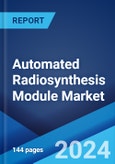The global automated radiosynthesis module market size reached USD 36.0 Million in 2024. Looking forward, the market is projected to reach USD 59.4 Million by 2033, exhibiting a growth rate (CAGR) of 5.43% during 2025-2033. The increasing prevalence of various chronic and cardiovascular diseases, especially amongst the geriatric population, along with the rising need for PET and SPECT scanners in the healthcare sector to create tomographic images and advancements in the healthcare sector represent some of the key factors driving the market.
Automated radiosynthesis module refers to advanced medical equipment designed to formulate the radioactive isotope with a tracer molecule that is suitable to perform intensive diagnostic and therapeutic procedures. The automated radiosynthesis module also employs positron emission tomography (PET) and single-photon emission computerized tomography (SPECT) scanners. These solutions improve the utility of tomographic imaging diagnostics methods. As compared to radiotracers and radiopharmaceutical units, it offers better scope for production customization, longer device life, setting-up convenience, and better operational efficiency while performing diagnosis and therapy administration. Along with this, the automated radiosynthesis module is readily usable and improves therapy monitoring activities. Consequently, it is extensively used across hospitals, laboratories, and clinics by healthcare practitioners. At present, automated radiosynthesis module is commercially available in full and semi-automated types.
Automated radiosynthesis module refers to advanced medical equipment designed to formulate the radioactive isotope with a tracer molecule that is suitable to perform intensive diagnostic and therapeutic procedures. The automated radiosynthesis module also employs positron emission tomography (PET) and single-photon emission computerized tomography (SPECT) scanners. These solutions improve the utility of tomographic imaging diagnostics methods. As compared to radiotracers and radiopharmaceutical units, it offers better scope for production customization, longer device life, setting-up convenience, and better operational efficiency while performing diagnosis and therapy administration. Along with this, the automated radiosynthesis module is readily usable and improves therapy monitoring activities. Consequently, it is extensively used across hospitals, laboratories, and clinics by healthcare practitioners. At present, automated radiosynthesis module is commercially available in full and semi-automated types.
Automated Radiosynthesis Module Market Trends:
The increasing prevalence of various chronic and cardiovascular diseases, including cancer and chronic obstructive pulmonary disorders (COPD), represents a prime factor driving the market growth. Additionally, the rising need for PET and SPECT scanners in the healthcare sector to create tomographic images have facilitated the demand for automated radiosynthesis module in the healthcare sector, which is acting as another growth-inducing factor. In line with this, the large-scale investments being made by several governments in the production of radiotracers in decentralized settings are further contributing to the market growth. Moreover, the rising awareness regarding the multiple product benefits, such as low capital cost, minimal infrastructural requirement, and optimal performance, is supporting the market growth. This can be further attributed to significant technological advancements in terms of its usage, features, and efficacy, which is considerably favoring the market growth. Additionally, the rising geriatric population, which is susceptible to chronic ailments, and the escalating mortality rates across the globe are propelling the market growth. Other factors, such as significant enhancements in the healthcare infrastructure, the recent research and development (R&D) activities, and the major strategic collaborations amongst key players to engineer new product alternatives with enhanced efficacy, are creating a positive outlook for the market growth. The market is also being driven by the significant expansion in the healthcare industry, along with funding and grants provided by government and private organizations to encourage the adoption of automated radiosynthesis module for various applications.Key Market Segmentation:
This report provides an analysis of the key trends in each segment of the global automated radiosynthesis module market, along with forecasts at the global, regional, and country level from 2025-2033. The report has categorized the market based on type and application.Type Insights:
- Fully Automated
- Semi-Automated
Application Insights:
- Hospitals
- Diagnostic Labs
- Radiology Clinics
- Others
Regional Insights:
- North America
- United States
- Canada
- Europe
- Germany
- France
- United Kingdom
- Italy
- Spain
- Russia
- Others
- Asia Pacific
- China
- Japan
- India
- South Korea
- Australia
- Indonesia
- Others
- Latin America
- Brazil
- Mexico
- Others
- Middle East and Africa
Competitive Landscape:
The report has also provided a comprehensive analysis of the competitive landscape in the global automated radiosynthesis module market. Detailed profiles of all major companies have also been provided. Some of the companies covered includes Eckert & Ziegler Strahlen- und Medizintechnik AG, Elysia S.A., General Electric Company, IBA RadioPharma Solutions, Optimized Radiochemical Applications, SCINTOMICS Molecular, Applied Theranostics Technologies GmbH, Synthra GmbH, Trasis, etc.Key Questions Answered in This Report:
- How has the global automated radiosynthesis module market performed so far and how will it perform in the coming years?
- What are the drivers, restraints, and opportunities in the global automated radiosynthesis module market?
- What are the key regional markets?
- Which countries represent the most attractive automated radiosynthesis module markets?
- What is the breakup of the market based on the type?
- What is the breakup of the market based on the application?
- What is the competitive structure of the global automated radiosynthesis module market?
- Who are the key players/companies in the global automated radiosynthesis module market?
Table of Contents
1 Preface3 Executive Summary10 Value Chain Analysis12 Price Analysis
2 Scope and Methodology
4 Introduction
5 Global Automated Radiosynthesis Module Market
6 Market Breakup by Type
7 Market Breakup by Application
8 Market Breakup by Region
9 Drivers, Restraints, and Opportunities
11 Porters Five Forces Analysis
13 Competitive Landscape
List of Figures
List of Tables
Companies Mentioned
- Eckert & Ziegler Strahlen- und Medizintechnik AG
- Elysia S.A.
- General Electric Company
- IBA RadioPharma Solutions
- Optimized Radiochemical Applications
- SCINTOMICS Molecular
- Applied Theranostics Technologies GmbH
- Synthra GmbH
- Trasis
Methodology

LOADING...








